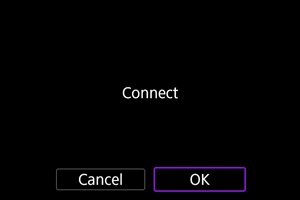Connecting to EOS Utility
- Operating the Camera Using EOS Utility
- Editing/Deleting Devices for Connections
- Reconnecting Using Connection Information
- Transferring Multiple Images at Once (Direct Transfer)
- Transferring RAW+JPEG or RAW+HEIF Images
- Creating and Registering Captions
This section describes how to connect the camera to a computer and perform camera operations using EOS software or other dedicated software. Install the latest version of software on the computer before setting up a connection.
For computer operating instructions, refer to the computer user manual.
Operating the Camera Using EOS Utility
Using EOS Utility (EOS software), you can import images from the camera, control the camera, and perform other operations.
Steps on the camera (1)
-
Select [OK].
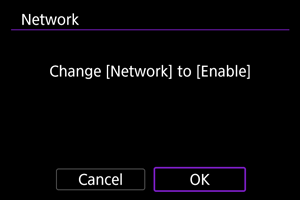
- This screen is not displayed if the network setting is already set to [Enable].
-
Select [Add a device to connect to].
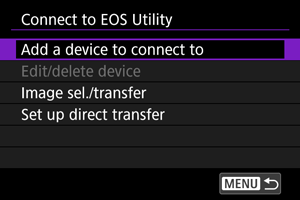
-
Select [New settings].
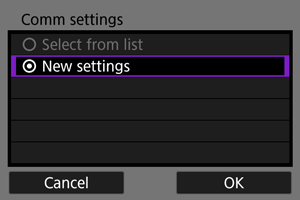
- Select [OK] to go to the next screen.
- By selecting [Select from list] when settings are already registered on the camera, you can apply the registered settings.
-
Select an option.
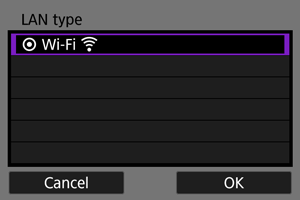
- Select [OK] to go to the next screen.
- For instructions on configuring communication functions, see Basic Communication Settings.
-
Save the settings.
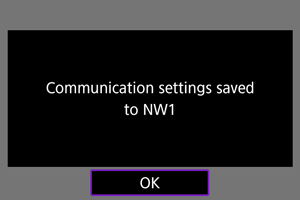
- Press
.
- The next screen is displayed after communication settings are complete.
- Press
-
Select [OK].
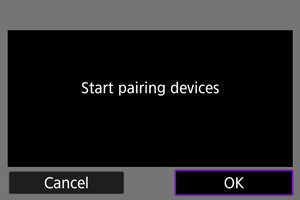
-
The following message is displayed. “******” represents the last six digits of the MAC address of the camera to be connected.
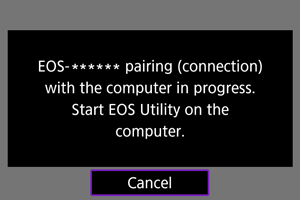
-
Steps on the computer
-
Start EOS Utility.
- Connect the computer to the network and start EOS Utility.
-
In EOS Utility, click [Pairing over Wi-Fi/LAN].

- If a firewall-related message is displayed, select [Yes].
-
Click [Connect].

- Select the camera to connect to, then click [Connect].
Steps on the camera (2)
-
Establish a connection.
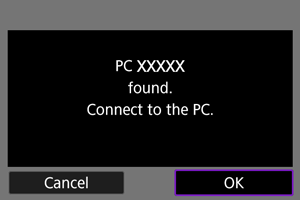
The camera and computer are now connected.
[ Communicating] screen
Communicating] screen

-
Image sel./transfer
-
Set up direct transfer
You can specify the format of images to transfer to a computer ().
-
Confirm settings
You can check setting details.
-
Error details
-
Disconnect
Terminates the connection.
Caution
-
The following will occur if you terminate the connection during remote movie recording.
- Any movie recording in progress in movie recording mode will continue.
- Any movie recording in progress in still photo shooting mode will end.
- You cannot use the camera to shoot in still photo shooting mode when it is set to movie recording mode in EOS Utility.
- With a connection established to EOS Utility, certain functions are unavailable.
- In remote shooting, the AF speed may become slower.
- Depending on the communication status, image display or shutter release timing may be delayed.
- In Remote Live View shooting, the rate of image transmission is slower compared to a connection via an interface cable. Therefore, moving subjects cannot be displayed smoothly.
Editing/Deleting Devices for Connections
Before editing or deleting connection settings for other devices, end the connection. This section covers items not described in Operating the Camera Using EOS Utility.
-
Select [Edit/delete device].
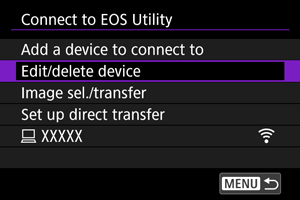
-
Select the device.

- Select the device for the connection, then press
.
- Select the device for the connection, then press
-
Select an option.

Changing device nicknames
You can change the nickname of devices the camera connects to.
Communication settings
Deleting connection information
You can delete the connection information.
Reconnecting Using Connection Information
The configured connection information can be used to connect again.
Transferring Multiple Images at Once (Direct Transfer)
With the camera connected to a computer (via Wi-Fi or an interface cable) and the main EOS Utility window displayed, you can use the camera to transfer images to a computer.
Caution
- If you will transfer many images, consider using a household power outlet accessory (sold separately).
Access the [ Image sel./transfer] screen.
Image sel./transfer] screen.
-
Select [Image sel./transfer].

- The [
Image sel./transfer] screen is displayed.

- For details on the [
Image sel./transfer] screen, see Using the [
Image sel./transfer] Screen.
- The [
Transferring RAW+JPEG or RAW+HEIF Images
For RAW+JPEG or RAW+HEIF images, you can specify which image to transfer.
-
Select [Set up direct transfer].
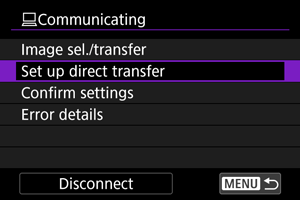
-
Select the type of images to transfer.

-
RAW+JPEG transfer
Choose from [JPEG only], [RAW only] or [RAW+JPEG].
-
RAW+HEIF transfer
Choose from [HEIF only], [RAW only] or [RAW+HEIF].
-
Caution
- Some menu items are not available during image transfer.
Creating and Registering Captions
You can create captions and register them on the camera to use them as described in Adding a Caption Before Transfer.
-
Start EOS Utility and select [Camera settings].

-
Select [WFT Captions].

-
Enter the captions.
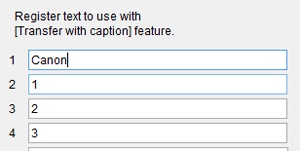
- Enter up to 31 characters (in ASCII format).
- To acquire caption data stored on the camera, select [Load settings].
-
Set the captions on the camera.
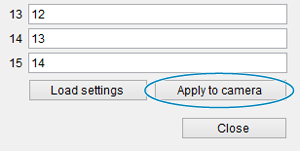
- Select [Apply to camera] to set your new captions on the camera.

